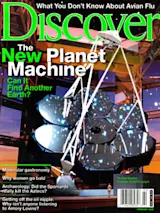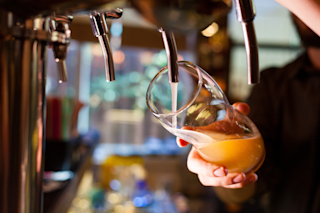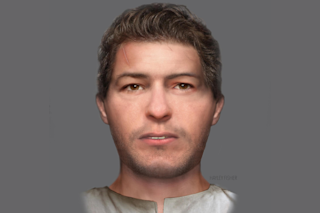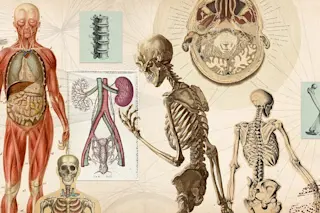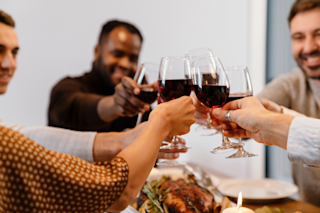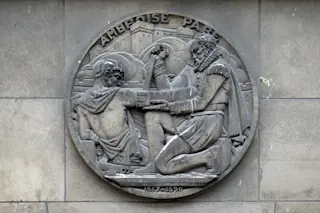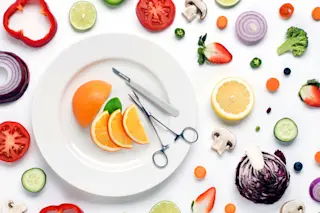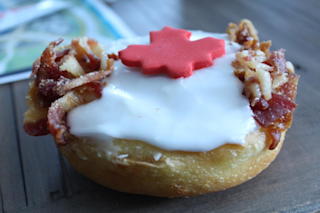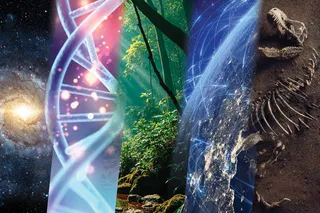Paris is sweltering, freakishly hot for an early June morning, and like much of the old city, the lab occupied by Hervé This at the Collège de France, a stone's throw from the venerable Sorbonne, has no air-conditioning. As usual, however, This—pronounced "tiss"—looks dapper in a black suit and one of the impeccable white collarless shirts that have become his trademark. A full day lies ahead in his lab, he says, but first we must shop. He bounds to his feet, ditches his jacket, and descends to the stifling street below, proceeds down a cobbled alley, crosses the boulevard Saint-Michel, rounds a corner, and dives into the local supermarché. He emerges with two dozen eggs and a cold brick of Normandy butter, his face crinkling into a grin. "For our experiments!" he announces. He has yet to break a sweat.
This is head of the molecular gastronomy group in the Collège de France's Laboratory for the Chemistry of Molecular Interactions. That's a mouthful to describe a lab that studies something simple: how the process of cooking changes the structure and taste of food. Nonetheless, molecular gastronomy marks the cutting edge of epicurism these days. Anyone who wields a saucepan is doing chemistry and physics, yet how many of us actually know what's going on in there? Molecular gastronomy aims to apply the piercing clarity of science to the culinary arts. Already in France, which takes the pleasures of the table seriously, molecular gastronomy is an officially recognized, government-funded science.
"Why molecular gastronomy?" asks This, heading off a question he's been asked many times before. "It sounds a little pompous, no? Why not . . . molecular cooking?" Easy, he replies. Cooking aims to produce a dish; it is a craft, a technique. Gastronomy is knowledge, albeit knowledge that can improve your cooking and your appreciation of it. Gastronomy is the science of anything to do with human nourishment, says This, more or less quoting Jean-Anthelme Brillat-Savarin, France's great food philosopher. Writing in 1825, Brillat-Savarin envisaged a discipline that would meld the physics and chemistry of food and cookery with the physiology of eating and especially with the glorious, sensual world of taste.
The "molecular" preface was added in the late 1980s by This and his late colleague, Nicholas Kurti, to evoke the chemical units that make up the water, fats, carbohydrates, proteins, and other compounds in food. Molecular had a dynamic, modern ring to it, perfect for ushering gastronomy into a new era. Besides, molecular gastronomy sounds so much more fun, sophisticated, and cultured than plain old "food science," a field with which it somewhat overlaps but that is largely geared to the mass-market needs of the food industry.
Not that This is a patronizing food snob. (Snobbism would be incompatible with his quest for objectivity, after all.) He would wholeheartedly agree with Brillat-Savarin that "a humble boiled egg" is as worthy of attention as "the banquets of kings." "If all you have to eat is this," he says, plucking an egg from its box and holding it between his thumb and forefinger, "it's important to cook it well."
Do we, though? The standard way to hard-boil eggs in Europe and America—10 minutes in boiling water—is not ideal, says This. The trouble, he notes clinically, is that 212 degrees Fahrenheit is far higher than the temperature at which the egg whites and the yolks coagulate. Egg whites are made up of protein and water (yolks contain fat as well). As eggs cook, their balled-up proteins uncoil into strands, and the strands bind together to form an intricate mesh that traps water. In essence, the proteins form a gel, a liquid dispersed in a solid. Boiling causes too many egg proteins to bind and form dense meshes, "so there is less sensation of water in the mouth," says This. Voilà: rubbery egg whites and sandy, grayish yolks.
The 10-minute egg is just the start of kitchen dogma. Our cookbooks are full of tips, caveats, and stipulations—précisions, as This calls them—drawn untested from tradition and folklore. "Cook meat at high temperature to seal in the juices? We've done the test—it's not true," says This. Use only eggs at room temperature for making mayonnaise? Not true either. Season steak with salt before cooking, or salt it afterward? Makes no difference, as the salt doesn't penetrate the meat. Parsing French recipes for a quarter century in his quest for gastronomic clarity, This has identified more than 25,000 such admonitions; so far only a few hundred have been investigated. So many précisions, so little time.
This, a physical chemist and a former editor of the magazine Pour La Science, first began his testing as a sideline, alone in a laboratory he'd set up at home. Then he met Kurti, the man who would become his colleague and friend. Kurti was a low-temperature physicist at Oxford University and an irrepressible bon vivant. If there is a father of molecular gastronomy, Kurti is he. Thirty-five years ago, he was already poking the probe of a thermocouple into a cheese soufflé to take its internal temperature, the better to track its vapor-assisted ascent. "We know better the temperature inside the stars than inside a soufflé," Kurti once lamented.
They must have made an odd couple: the short, rotund, Hungarian-born Kurti and the tall, dashing, much younger This. Together they formed the International Workshops on Molecular Gastronomy and began corralling colleagues keen on kitchen science: the American food scholar Harold McGee and the British physicist Peter Barham along with open-minded chefs, critics, and writers who were passionate about food and good-humored enough to put their dearly held ideas (not to mention their egos) to pitiless scientific test. As a meeting place they chose Erice, a monastic town on a Sicilian mountaintop that was already a favorite retreat for physicists like Kurti. Although Kurti died in 1998, the motley group continues to meet every few years to trade information, ideas, and occasional insults, share a few late-night glasses of the local marsala, improvise a test kitchen in a monastery courtyard, and form the foundations for a truly modern cuisine.
The workshops are dizzying affairs. Topics for the texture workshop five years ago included the biomechanics of chewing and swallowing; the structure of meat and how cooking affects it; foams and gels, featuring custards and chocolate mousses; the effects of microwaves on spongy foodstuffs like eggplants and mushrooms; and, on the last afternoon, a marathon session on the fractal nature of baba au rhum dough, conducted by a group of cantankerous physicists. "Well, that's why they are workshops, not lectures—to encourage the free exchange of ideas," This commented at the end of the day.
One participant at the texture workshop was Heston Blumenthal, a radical young British chef and the owner of the Fat Duck, near Windsor. Blumenthal was already receiving raves for the melting tenderness he coaxes out of lamb, achieved through his understanding of how heat diffuses in meat, and for the creation of a fabulous cookie—one that fizzes carbon dioxide in your mouth like so many tiny champagne bubbles. Today the Fat Duck has three Michelin stars and a biochemistry grad student in its development kitchen. Blumenthal is increasingly mentioned in the same breath as Ferran Adrià, the legendary Catalan chef at El Bulli, in Roses, two hours from Barcelona, whose superinventive and rather cerebral cuisine has drawn inspiration from the laboratory for years.
The ascent of the nerdy chef in Europe hasn't gone unnoticed in the United States. Suddenly science—once regarded with suspicion by foodies—looks like the next new thing. The term molecular gastronomy has begun popping up in restaurant reviews and on the food blog eGullet as a label for any edgy, out-there cuisine that combines unusual ingredients and employs techie gadgets.
"Because the phrase was around and catchy, it got applied to anyone experimenting with food," says McGee, an Erice regular. "Let's just say that many people aren't using molecular gastronomy to mean what Hervé means by it."
The confounding of molecular gastronomy with a sort of hipster cuisine drives even a patient man like This a little crazy. Non, non, non: Molecular gastronomy isn't a cooking style, he insists. "We shouldn't confuse science with technology. Molecular gastronomy is only the science part. It asks: How does something work? What is the mechanism? The application of that knowledge is the cooking part, and that's technology. Cooking is a technique"—his voice softens—"combined with art." He adds, "Here in the lab, we do the science part—experiments."
He introduces a Spanish student whose doctoral thesis investigates the effect of heat on two vegetable pigments, chlorophyll and carotenoids. Other students, using chromatography and nuclear magnetic resonance spectroscopy, for instance, are studying complex mixtures like meat and vegetable stocks. "You will see, we will do some experiments too," This says. "They will be simple, don't worry." You really can try this at home.
We begin by tackling the "standard model," the 10-minute egg. Can it be improved upon? Well, says This, if your grandmother cooked eggs that way for you, and you adored her and her cooking, there'll be no persuading you of a better way. (As This is fond of saying, "The most important ingredient in cooking is love.") But if you're willing to learn a little egg-protein chemistry, you can calibrate your eggs with astonishing exactitude.
Recall that when an egg cooks, its proteins first unwind and then link to form a rigidifying mesh. But not all its proteins solidify at the same temperature. Ovotransferrin, the first of the egg-white proteins to uncoil, begins to set at around 61 degrees Celsius, or 142°F. Ovalbumin, the most abundant egg-white protein, coagulates at 184°F. Yolk proteins generally fall in between, with most starting to solidify when they approach 158°F. Thus, cooking an egg at 158°F or so should achieve both a firmed-up yolk and still-tender whites, since at that low temperature only some of the egg-white proteins will have coagulated.
"Cooking eggs is really a question of temperature, not time," says This. To make the point, he switches on a small oven, sets the thermostat at 65°C, or 149°F, takes four eggs straight from the box, and unceremoniously places them inside. "I use an oven in the lab; it's easier. But if the oven in your kitchen is not accurate, cook eggs in plenty of water, using a good thermometer." About an hour later—timing isn't critical, and the eggs can stay in the oven for hours or even overnight—he retrieves the first egg and carefully shells it. "The 65-degree egg!" he announces. The egg is unlike any I've eaten. The white is as delicately set and smooth as custard, and the yolk is still orange and soft. It's not hard to see why l'oeuf à soixante-cinq degrés is becoming the rage with chefs in France. (Salmonella can't survive more than a few minutes at 60°C, or 140°F, so a 65-degree egg cooked for an hour should be quite safe.)
Next, This turns up the oven thermostat to 67°C, or 153°F, and after waiting a while for the eggs inside to reach that temperature—again, he's casual about the timing—he retrieves a second one: "The 67-degree egg!" At this temperature the yolk has just started thickening up—some of its proteins have coagulated, but the majority have not. "Look, you can mold it," he says, scooping out the yolk and manipulating the pliable orangey-yellow ball like fresh Play-Doh. He tries to mold a heart, then settles for a cube.
"Try one," he says, taking a third egg from the oven for me to play with before turning up the heat to 158°F (70°C). The 70-degree egg, when it is finally done, has a moistly set yolk and a very tender white. "So you see, you can adjust the temperature depending on what you want," says This. If you prefer a firmer egg, cook it at 167°F or 176°F. Bear in mind, though, that the most copious of the egg-white proteins sets at 184°F—hence the rubbery results of the 212-degree bath.
So familiar is This with this process that he can tell at a glance the temperature at which an egg was cooked. During lunch at a local bistro, I notice a 65-degree-Celsius egg on the menu, served on a fricassée de girolles. As the plate is set down, This says: "That's not a 65-degree egg. It's a 64-degree egg." The yolk is soft, and the egg white, while completely opaque, is so delicately jelled and fragile that it breaks apart slightly when it is plated. "Eh, oui," the chef sighs; he is having des ennuis regulating the heat of his stove. Never mind that the presentation isn't completely perfect—the egg, mixing in with the earthy mushroom stew, is delicious.
Back in his laboratory, This puts on a lab coat to protect his shirt "so my wife won't complain that I make spots on it." He breaks a raw egg one-handed, plops the white into a bowl, and starts rapidly whisking. Whisking, of course, incorporates air into the aqueous white. It also causes some proteins in the egg white to unfold. The resulting protein strands then form a mesh around the air bubbles, stabilizing the foam. Usually an egg white produces about half a pint of foam.
Why not more? asks This, whisking like a demon. It can't be lack of air—there's an endless supply—so it must be lack of water. He adds a squirt to the beaten egg white, whisks again, squirts water, whisks some more. The snowy mass keeps growing. "If I went on beating I could get liters and liters—gallons of foam!—from one egg white," he says, pausing at last to wipe his brow. With a thunderstorm brewing, the lab feels muggier than ever, and even This shows signs of wanting a break. "So you see, you only need one egg to make a lot of mousse, enough for a dinner party." However, the foam will be less stable, because the viscosity of that single egg white has been diluted. Whisking hard helps, as smaller bubbles are more stable. So does beating in sugar (or gum), which stabilizes the foam by increasing its viscosity.
The voluminous-egg-white stunt was first used for an educational project in French schools. Later, it occurred to This that it could be put to culinary use. Eight years ago he struck up a collaboration with one of France's most lionized chefs, Pierre Gagnaire. The two regularly rendezvous to brainstorm: This tosses up new culinary concepts based on his scientific musings, and Gagnaire transforms them into elegant recipes. This proposed replacing water in the expanded egg-white foam with a flavorful liquid to make an ethereal perfumed meringue, an invention he named cristaux de vent, or "wind crystals." Gagnaire's creation: a soft black olive buried inside a crisp meringue made light as air with the olive's own pickling brine.
This and Kurti envisaged a day when molecular gastronomy would help people cook in entirely different ways; they never guessed that day might come so soon. Quite a few chefs are toying with chemicals pulled from the lab shelf, using new jelling agents, for instance, to encapsulate sauces and liquids in a fragile, jellified skin, like salmon eggs. "It's truly the terra incognita of cooking," This says: full of potential for brilliant, thrilling innovation, or for dreadful mischief if explored without discernment. And it's bound to stir up a stew of admiration, bemusement, wonder, and ridicule—in short, gloriously animated debate.
The following day this has an appointment with Gagnaire at his restaurant on a corner of the rue Balzac. You could call their collaboration a tech transfer. "Mad," says This affectionately of his collaborator in the taxi on the way there. "Even madder than me."
Gagnaire is a little late, fresh off the Eurostar from a conference in London. He has a world-weary mien, or maybe he's just tired: intense pale blue eyes, an angular nose, a slight beard, flopping hair—a corsair in chef's whites. The two men embrace happily on meeting and quickly settle down to business in the salon adjoining the dining room. This's laptop comes out, and notebooks appear on the table. This begins serving up a generous helping of ideas, his mind racing; Gagnaire keeps up, peppering him with questions, taking notes, riffing on This's suggestions. Yes, yes, the texture of a taste is very important, says Gagnaire during a discussion of various jelling agents like methylcellulose and alginates. A taste can change with a change in the texture or the surface of the food. Which scientist, Gagnaire wants to know, has studied the effect of surfaces on taste? Later, This reviews plans for an upcoming dinner in which each dish will be named for a scientist and evoke his work: le dessert Einstein, le plat Faraday, la sauce Pasteur.
"OK, d'accord," Gagnaire says gallantly. Jazz plays softly over the restaurant's sound system. There's a clink of cutlery, a murmur of appreciative conversation from the dining room. Fleets of beautiful little dishes begin to arrive. One, a dish of sweet mild scallops and mussels in a pool of consommé, is enlivened by a rust-colored cream of araignée de mer—spider crab—that floods the mouth and nose with sea aromas. Beside it sits a salad of meaty tomatoes, with tangled greens and seaweed on a sauce dark as night, and white wind crystals, the ethereal meringues that Gagnaire impregnates with black olives. It's a deceptively simple combination: plush tomatoes, the tang of slippery seaweed, the meringue crisp and sweetish at first bite, then soft and pungent with olive on the inside.
As soon as this dish is whisked away, I want more. Jean-Anthelme Brillat-Savarin, the original gastronome, was on to something. "The creation of a new dish," he wrote in The Physiology of Taste, "does more for the happiness of mankind than the discovery of a new star." If Nicholas Kurti is the father of molecular gastronomy, and Hervé This is its son, then Brillat-Savarin surely is its holy ghost.


